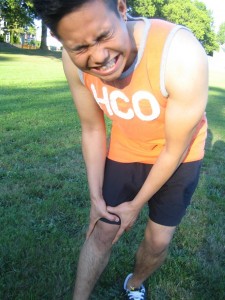The knee has two types of cartilage that can be damaged – meniscus cartilage and articular cartilage. The articular cartilage is a smooth and semi-rigid tissue that wraps the ends of bones while at the same time allowing the knee joint to freely move. It can be torn away by impact during contact sports or gradually wear down with age.
The meniscus cartilage is the crescent-shaped cushion between the inferior part of the thigh bone and upper part of the shin bone. If the meniscus is absent, the bones on both the upper and lower leg will grind on each other, resulting to momentary pain and long-term arthritis. There are two menisci – lateral (exterior of the knee joint) and medial (within the joint). The medial meniscus is commonly damaged during sports.
How a torn meniscus occurs?
An individual will suffer from a torn meniscus once he/she sustains a blow on the exterior of the knee, pushing it internally and eventually ripping the structure or it can also occur due to the compression or bending of the knee joint. Take note that it is not unusual for a torn meniscus to occur at the same time with other traumatic injuries such as a torn ACL (anterior cruciate ligament).
Among older individuals, the meniscus becomes tattered and weak, thus making it prone to both contact and non-contact injuries. Even the simple up and down motion in squatting can cause a minor meniscus tear.
Who are at risk?

Those who play tennis, basketball, soccer, lacrosse or football who plants the foot in order to change directions or sustains a hit from another player are prone to meniscus injuries. An individual who steps in a hole can also suffer from injuries.
Men are more susceptible to a torn meniscus than women, but this might be due to the higher number of men engaging in sports.
What are the symptoms of a torn meniscus?
- Pain on the interior of the knee joint or dull pain all over the joint
- Pain that can diminish for a few days and then return with physical activity
- Popping sound when the injury was sustained
- Stiffness
- Swelling within 24-48 hours after the injury
- Weakness of muscles
- Inability to bend the knee completely
- Inability to put weight on the knee joint
- Locking of the knee at a 45-degree angle
Treatment for a torn meniscus
As a first aid measure, instruct the individual to rest and to avoid any physical activity. Apply an ice pack or cold compress in 20 minute intervals several times in a day during the initial 48-72 hours after the injury. Elevate the knee while at rest during the day and when sleeping by using cushions or pillows.
Over-the-counter medications such as ibuprofen, naproxen, acetaminophen or aspirin can help relieve the pain. After 48-72 hours, you can use moist heat in order to increase the circulation to the affected area as well as relieve discomfort. In case the pain lasts for a week or more, it is best to seek medical care right away.
